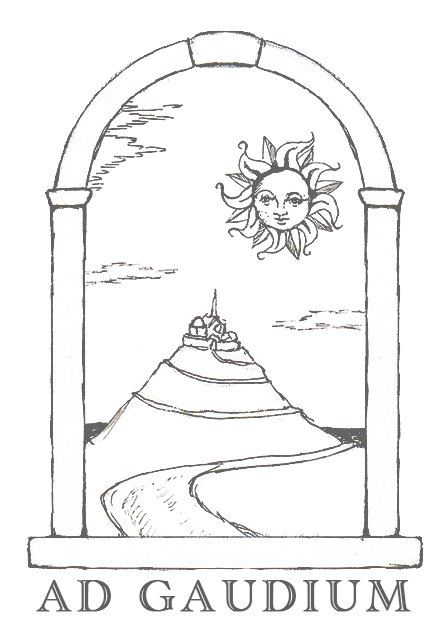On Gifts: The Beginning of our Project
No gift comes without strings. It arrives pulling its own freight of thoughts, feelings, and potential interpretations. It has a meaning, a poetry, an ethic woven into the very fact of its being a gift. How it is given and how it is received have a resounding impact on a person’s life. You might tell a pretty complete history of a family or group just by listing the gifts that “landed well” and those that sowed jealousy and resentment.
An awareness of this complexity hovered like a cloud over my mind, as I sat on the floor of our family room one December night wielding a utility knife, trying to slice neatly through an amazon packing box that I’d covered over with sticker paper. I was making a gift. It was an impulsive gift; an unlooked-for gift. It was a gift that felt perhaps a little excessive, a little presumptuous, and little too far from convention. But joy and fear beat in my chest, and I felt an unusual purpose that night. I felt that perhaps I was working under the hand of a holy muse—if muses take interest in cardboard boxes.
The project I was attempting was a homemade advent-calendar-style box, with doors that open. It wasn’t a countdown to Christmas (we were already half way through December). This was a “Calamity Calendar:” a box with doors to be opened amidst the upsets and collision of a difficult season of life. I hoped the box would provide a little relief on a rough day--love in a time-release form.
Now to tell about Jen, my box’s recipient. She’s a friend in my neighborhood, a homeschooling mother about eight years my senior. She leads a women’s faith group that I attend. She and I form half a chapter of a Well-Read-Mom book club. In the four years since my moving to North Carolina, we’ve shared life in many ways, and she has been for me, an entry point into a community of mothers. During the height of the pandemic, she was a lifeline. We had weekly electronic show-and-tells where our kids would share what they were working on---paper and polymer clay creations, card games, felted creatures—and after the children drifted away, I carried my laptop to some recess of the house, and poured out my frustrations and worries to Jen’s receptive ear. She would talk me down, and tell me I was doing better than I thought, and share her experience pursuing this or that therapy or trying a technique for teaching spelling. Objects would arrive at our doorstep from Jen’s house---many of them tools of the mothering trade---wiggle seats to help restless little bodies stay in a chair, books on the lives of the saints, books for parents about sensory integration, and a long-armed stapler to help in our effort to make travelers’ notebooks. There was a Valentine’s day when we were surprised with homeade caramels, collage art valentines, and chocolate-dipped
popcorn.
Then came the thawing of the pandemic, and better times when meeting in person became possible. I see my friend now, as she is at our book discussions. She perches on the couch, her dark eyes momentarily downcast as gathers her thoughts—strands of mahogany hair frame her face. She has made a connection between the literature and a point of theology. There, in the mix, is a newly-minted metaphor. She lifts her eyes and gestures as though to bring the pieces together in the air before her. The joy is upon her, the beauty of the ideas light her eyes and animate her finger tips.
Jen is an artist, a crafter, a poetess. To enter her home is to be soaked in color—painted seascapes and portraits of laughing children adorn walls of pink and blue and yellow. She’s a sensitive soul, with a high ideals, and an awareness of life’s deep suffering.
Jen has a thirst for calm that’s rarely slaked. For she has four sons jostling into adulthood—lanky, dark eyed-and full of intensity. They have a brilliant and baffling mix of special gifts and special needs, and Jen has learned through the long road of mothering and homeschooling that conventional methods and wisdom don’t apply to her brood.
This past December, Jen was finding it particularly rough. There were tumultuous family relationships to be negotiated. Jen was chasing down a medical diagnosis for her thirteen-year-old son---and---surprise, surpise---the thirteen year old wasn’t cooperating.
Besides this, there was the ordinary December panic we mothers feel—when something in our ancient physiology marks the dying of the light and yells “hurry, hurry!”while the voice of holiday commerce yells the same.
And so I was making a calamity calendar for my friend. Because calamities were coming—life would see to that.
I gathered objects from my house---things as lovely and pristine as I could find: a new pair of wool socks, a wood-burned spoon with the figure of an owl, a pair of earrings with faceted quartz dangles, another pair with fleur de lys painted on porcelain, a peg doll angel, lavender sachets, a fresh chapstick. I taped and tied these into the box.
Finally, in the interior of the box, I tied a tiny framed painting I had made years before and fortunately happened upon while going through some files. The painting depicted Mary and Elizabeth at the Visitation, arms around each other and halos touching. In Rumor Goden’s In This House of Brede, Dame Catherine muses on the Visitation:
[She] thought, as the antiphon to the Magnificat was sung, of the Visitation, when the Virgin Mary, with the angel’s announcement beating in her heart, had gone ‘in haste,’ as Saint Luke says, to visit her far older cousin. Why, wondered Abbess Catherine, did theologians always teach---and we take it for granted--that Mary went simply to succor Elizabeth”. Probably she did do that, but could it not also have been that she needed the wisdom and strength of an older woman? How wonderfully reassuring Elizabeth’s salutation must have been: “Why is this that the mother of my Lord should come to me?” A recognition without being told, and Mary, as if heartened, touched into bloom by the warmth and honor of that recognition, had flowered into the Magnificat.”
(In the House of Bride, Chpt 7).
Since my reversion to Catholicism 17 years ago, I’ve thought of the Visitation as a benediction on female friendship. We do best when we organize our female community under the Aegis of the Visitation. It’s a pattern to follow: to encourage one another in our joys and travails, and acknowledge that Christ is among us--in ourselves and in the persons of our children and husbands.
Now this diminutive piece of art seemed just the thing to express the intention of the Calamity Calendar. For wasn’t this archetypal story of Grace now being echoed in our friendship? Mother greeting mother. The kindness of one, permitting the flowering of the other.
I gave the calendar to Jen a few days later, handing it over in a plastic sack at the end of a school open house. “I had a crafting spasm” was my rueful explanation, a little worried of having the gift exposed to discussion. Jen peered inside, “I see the words ‘Calamity Calendar,’ I’m intrigued!”
A day or so passed and the first text came---a picture of the peg doll angel and a message overflowing with appreciation. The expressions of gratitude continued as Jen opened the calendar doors in the following weeks. She wore the earrings and I saw with pleasure how well they suited her--well beyond my planning. It seemed apparent that they had come into my possession in order to be transferred to her. And each time, I felt my own gratitude well up to meet Jen’s. What a grace for me to be allowed to participate in my friend’s life in this way--to be part of the work of mercy? “Why is this that the mother of my Lord should come to me?”
Flush from the joy of this exchange, I considered that this sort of gift format could have a broader appeal--that it could answer a need in modern life to meet others in the midst of their daily struggles and joys. Perhaps it could be a little business. I told this to another friend, my youngest Child’s godmother, when she called to wish us a
happy Epiphany. We had just received a care package from her:“Simone, you’d do so well populating such a calendar box. You have such a knack for gathering lovely gifts that cover all the bases!”
For me, it was a fancy--something fun to talk about. But Simone felt the quickening of a viable business. She took up the torch and ran with it.
We ‘re now a little more than four months out from that conversation, and we plan to launch our business at the end of April. We have a name (Ad Gaudium Collective) and a name for our flagship box (Journey to Joy Box). Thus far, we’re four mothers working to make this dream come about. We hope and pray that our boxes will make it easier to give the gift of encouragement, and leaven everyday tasks and hardships with meaning.
Thus far, the business has been such a gift to Jen, Simone, and our other collaborators. We’re finding fertile ground for our talents and ideas. Jen and I get to use our art, and our love of literature, as we hunt up quotes appropriate to the boxes.
The cloud of ambivalence and complexity that hung over me that evening I worked on the box has receded.
I’ll leave you now with one of my favorite quotes on the giving and receiving of gifts:
For in truth it is life that gives unto life--while you, who deem yourself a giver, are but a witness. And you receivers---and you are all receivers--assume no weight of gratitude, lest you put a yoke upon yourself and upon him him who gives. Rather rise together with the giver on his gifts as on wings; For to be overmindful of your debt, is to doubt his generosity who has the free-hearted earth for mother, and God for father.
(Kahlil Gibran, The Prophet)

